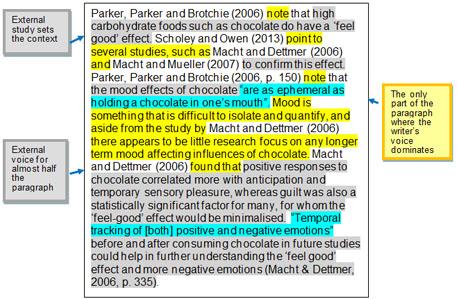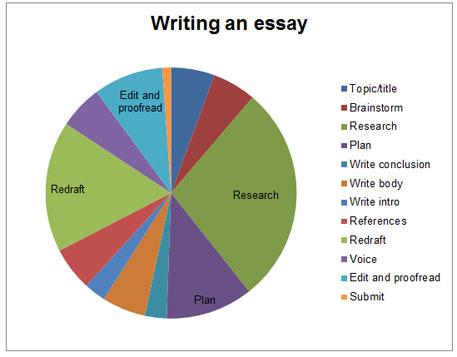Essay Writing
Ms Parrot: Essay Chef
View the video, then try the essay exercises to test your knowledge! Watch the whole story, or see sections of the story below. All the videos have captions that you can view on YouTube.
View the video on the Chinese site youku.
-
View the individual video chapters
To view the individual chapters of the above video, you can either click the 'PLAYLIST' menu item in the above YouTube video and select the chapter from there, or, you can click one of the links below and view the individual video on YouTube.
Exercises
- Exercise 1: Introductions
- Exercise 2: Conclusions
- Exercise 3: Voice
- Exercise 4: Paraphrasing
- Exercise 5: Referencing
- Exercise 6: Academic Integrity
Resources
Download the transcript of the video or download the exercises in PDF format or as a Word document.
-
Essay structure
Essays help you discover more about a topic and write a reasoned analysis of the issues in question, using a range of external sources to support your position.
An essay is a highly structured piece of writing with follow a typical pattern:
Section Explanation of section contents 1. Introduction Background statement — where you set the context for your essay
Issue(s) — where you outline the specific issues that are relevant to your essay.
Thesis — where you state your position in relation to the issues.
Scope — where you outline what exactly is going to be covered in relation to your argument.2. Main body Each paragraph should focus on one idea only.
The idea can then be developed in a number of ways, such as through explanation, evaluation, exemplification or incorporation of research data.
Your paragraphs should be balanced — keep to the rule of no less than 3 sentences per paragraph.
Your paragraphs should link together — use connective words, both within and between paragraphs, to keep a sense of cohesion and linkage.
3. Conclusion Begin with a link to the preceding paragraph.
Restate your thesis and summarise your principal points.
End with a broad statement relating to the significance of your argument.
Writing a good essay can be compared to baking a cake—if you do not mix the right ingredients in the right quantities or order, and do not follow the required processes, then the end result will not be what you hoped for!
There is no set model for an essay, but the English for Uni website presents one popular way to do it. The following example is based around a 1000 word discussion essay. To read about essays in greater detail, download this PDF or Word document. -
Topic/title
It is important for you to analyse your topic and title very carefully in order to understand the specific aim of the question. To do this, you need to break down the question. Most essay questions will contain these three elements:
Content/Topic words give the subject of the essay.
Limiting/Focus words provide a narrower scope for the essay.
Directive or Instructional words tell you how to approach the essay.
Look at these sample essay titles from A) Economics and B) Nutrition:
In example B, answering the question fully involves looking closely at the directive word Discuss and analysing its exact meaning.
Discuss: Present various points and consider the different sides. A discussion is usually longer than an explanation, as you need to present evidence and state which argument is more persuasive.
So, in your essay entitled:
“Chocolate is a healthy food”. Discuss.”
you would need to:
- consider a number of points in relation to the title
- balance your points between supporting and opposing positions
- consider which of the positions is the most persuasive and explain why
You also need to consider the length of your essay. In a 2000 word essay you can cover more points than in a 1000 word one! This example is based on a 1000 word essay.
In relation to Content words your focus is clear: chocolate!
In relation to Limiting words, you need to consider what healthy food actually means. A good way to expand your vocabulary is to look at the Academic Word List (developed by Averil Coxhead at Victoria University of Wellington in New Zealand). The uefap website also has very useful lists of words found in particular subjects, such as mathematics, business and health science.
Directive or Instructional words
There are a number of directive words, or instructional words as they are sometimes called, which tell you what to do in your essay. Some common directive words include:
Analyse Look at something in depth, examining the details. Argue Give reasons for why you agree or disagree with something and show that you understand different points of view. Assess Compare different points and see if the argument or information is true or persuasive. Compare Show the similarities between two sets of information or arguments. ‘Compare’ often appears with ‘contrast’ in essay questions. Contrast Show the differences between two sets of information or arguments. ‘Contrast’ often appears with ‘compare’ in essay questions. Criticise Evaluate an argument or a text to see if it is good. ‘Criticise’ does not mean you have to be negative. Critique Evaluate an argument or a text to see if it is good. ‘Critique’ does not mean you have to be negative. Define Explain the meaning of a word or a term, especially in the context of your essay. You can use a dictionary definition if it’s helpful, but remember that the word might be used in a particular way in the subject you are studying. Describe Give details about something. Discuss Look at the different sides of an argument and say which is more convincing. Help your reader to understand more about something by giving relevant details. Evaluate Look at the strengths and weaknesses of the material and give your final opinion of it. Examine Look at the strengths and weaknesses of the material and give your final opinion of it. Explain Help your reader to understand more about something by giving relevant details. Illustrate Give examples to make something clearer. Interpret Help your reader to understand more about something and provide your own perspective if necessary. Justify Give reasons to explain what you think about a subject. Outline Give a broad explanation of something without too many details. Prove Show if something is true and demonstrate how you reached that conclusion. Review Look at something in detail and give your perspective on it. State Put your ideas or arguments clearly. Summarise Pull everything together and present it clearly without using too much detail. -
Brainstorming
Brainstorming means producing ideas related to a theme. You can write the ideas down in any order.
Here is a possible brainstorm for the chocolate essay, done in the form of a mind map:
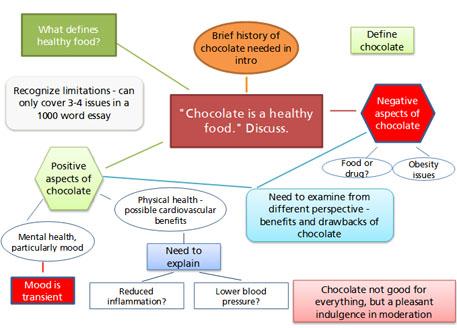
Text description of the above image.
Note that the central focus (the essay question) has several boxes linked to it which represent the writer’s first ideas. Other boxes area then added. A brainstorm like this is organic; it does not necessarily stop growing. You can add, remove or reorganise it as you wish. If you like to put more system into your brainstorm, use a step-based model such as the following:
Step 1
Time yourself for the first draft of your mind map
Set a fixed time for this drafting from your base topic/question and stick to it.Step 2
Look critically at your draft
Which ideas could you develop or remove? Is there a balance of ideas?Step 3
Think about ordering
Which issues might you tackle first in your essay and why?Step 4
Anticipate readers’ needs
Are there any words and/or phrases that might need explaining? If so, when is the best time in the essay to do this?Step 5
Move
Reflect upon your brainstorming. Once you are happy with your brainstorm you can use it to plan your essay. -
Researching for your essay
Once you have done some brainstorming, it’s time to get researching!
Remember that an academic essay requires academic sources.
Finding what you want takes time and effort. The best place to start (assuming you haven’t already been given a prescribed reading list!) is by using an academic database. If you are not sure how to use a database, then book an appointment with your subject librarian at your institution.
Another option is to use an internet academic search engine such as Google Scholar. N.B. Make sure you are logged in to the library at your educational institution, so that you can use the full database capacities linked to Google Scholar.
You need to enter keywords to begin with. For the chocolate essay, one of the first associations we thought of was chocolate and mood. If we enter these words into Google Scholar it will look like this:
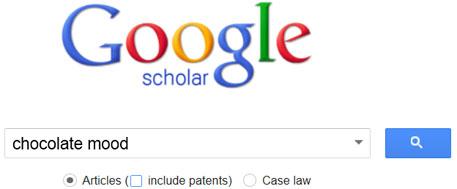
This will take you to a webpage which lists a number of relevant articles, like this:

The first two articles have been cited 90 times and 103 times respectively, suggesting that they might be good sources for your essay. The links to the right indicate that you can access the articles through your university website.
If you think an article looks promising, click on the link and look at the abstract:
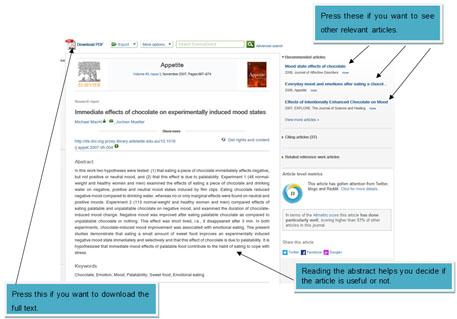
Read the abstract and ask yourself if the content of the article is likely to be relevant to your essay.
a) If yes, click on the PDF. This will take you to the full article which you can then skim read quickly to decide if it is relevant.
b) If no, then you have a choice. Either click on the links to other related articles or go back to Google Scholar and then choose another article to skim read.If you do not find what you are looking for, then you need to change your keywords search.
When you have found what you think might be useful, make a note in your plan at the appropriate place.
Do the same thing for all the points that need academic references to support them.
Remember that during your research you might discover new issues and perspectives that you hadn’t considered before, so your original plan might be quite different from the final one!
-
Planning your essay
Once you have brainstormed your ideas and done some initial research, start putting them into a logical order as part of the essay planning process. Brainstorming helps you to see what you know about the topic. Researching will give you more depth. Brainstorming, researching and planning are cyclical, which means that each process helps the other processes and you might want to do each process more than once.
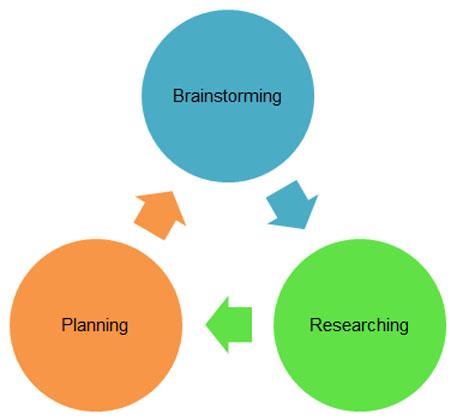
Here is the brainstorm for the chocolate essay again, which you can use to develop the planning process:
Planning or a plan?
In the first instance, it is important to distinguish between planning and a plan.
Planning is an ongoing process, from when you receive the essay title to when you submit your final draft.
A plan is a physical outline of the way you intend to conceptualise, structure and present your ideas.Plans can be structured/restructured at any time during the planning process.
At this point it is time to write your first plan. However, do not stop doing research yet. Why not?
A plan helps you to put your ideas into a form which gives you a clear direction for your reading. Once you have written your ideas up into a plan, you are beginning to give a structure to the essay writing process in order to make your argument more coherent. You might surprise yourself by discovering you know more about the subject matter than you thought. This can help build your confidence. 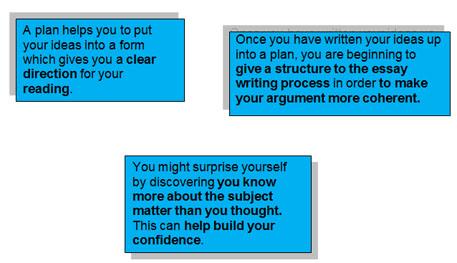
Remember that a plan is just that—a plan. It can be modified after you do more research; you might discover some different perspectives or issues you hadn’t previously anticipated.
Example: Developing an essay plan after research (linear style)
Title: “Chocolate is a healthy food.” Discuss.
Introduction
Context for paper – popularity of chocolate.
Issue – whether chocolate is a healthy food is questionable.
Thesis – chocolate may be enjoyable but not healthy.
Scope – (only 4 aspects are covered here to keep the example short)Positive: Can positively impact on mood Positive: Possible health benefits for cardiovascular system Negative: Chocolate can be seen as a drug rather than a food Negative: Potential correlation between over-consumption of chocolate and obesity
Main body
Paragraph 1 with possible sources
Ways in which chocolate can impact positively on mood. ‘Feel good effect’ - Parker, Parker and Brotchie (2006), Scholey and Owen (2013), Macht and Dettmer (2006) and Macht and Mueller (2007).Is the chocolate and improved mood scenario measurable/transient? Parker, Parker and Brotchie (2006) – chocolate mood effects do not last. Macht and Dettmer (2006) – anticipation effect and more studies needed.
Paragraph 2
Possible benefits of chocolate on cardiovascular health – how much/what type(s) of chocolate have benefit? (Sources needed to help answer these questions.)
Problems with measuring correlation between chocolate consumption and cardiovascular health. (Sources needed to help answer this.)Paragraph 3
Chocolate best viewed as a food or a drug?
Indulgence or addiction – are the boundaries unclear? (See what external sources have to say on this)
Medication elements of chocolate? (Readings needed around this issue.)Paragraph 4
The correlation between chocolate and obesity.
(Definition of obesity needed.)
What does the literature say in relation to other causal factors?Conclusion
Summary of four arguments presented.
Chocolate is not a healthy food, but it is enjoyable nevertheless.Example: Developed essay plan (linear style)
Title: “Chocolate is a healthy food.” Discuss.
Introduction
Context for paper – popularity of chocolate.
Issue – whether chocolate is a healthy food is questionable.
Thesis – chocolate may be enjoyable but not healthy.
Scope – (only 4 aspects are covered here to keep the example short)Positive: Can positively impact on mood Positive: Possible health benefits for cardiovascular system Negative: Chocolate can be seen as a drug rather than a food Negative: Potential correlation between over-consumption of chocolate and obesity Main body
Paragraph 1
Ways in which chocolate can impact positively on mood. ‘Feel good effect’-Parker, Parker and Brotchie (2006), Scholey and Owen (2013), Macht and Dettmer (2006) and Macht and Mueller (2007)Is the chocolate and improved mood scenario measurable/transient? Parker, Parker and Brotchie (2006) chocolate mood effects do not last. Macht and Dettmer (2006) – anticipation effect and more studies needed.
Paragraph 2
Possible benefits of chocolate on cardiovascular health – how much/what type(s) of chocolate have benefit? Can provide heart-friendly flavanols (Hannum, Schmitz, & Keen, 2002) – helps with blood clotting and is anti-inflammatory (Schramm et al., 2001)
Maximising benefits of chocolate lies in minimising fat levels (Hannum, Schmitz, & Keen, 2002). Current processes destroy flavanols (Hannum, Schmitz, & Keen, 2002). Note the change of focus from the original idea (correlation between chocolate consumption and cardiovascular health) due to the lack of research data available.Paragraph 3
Chocolate best viewed as a food or a drug?
Indulgence or addiction – are the boundaries unclear? Chocolate contains some biologically active ingredients, but in small amounts (Bruinsma & Taren, 1999). ‘Chocolate addicts’ – negative correlation: chocolate consumption and mood (Macdiramid & Hetherington, 1995) but chocolate cravings sensory rather than addictive (Bruinsma & Taren,1999).
Medication elements of chocolate? Used in relation to magnesium deficiency in women (Pennington, 2000 in Steinberg et al., 2003). Findings concur with Abraham and Lubran (1981) who found a correlation between magnesium deficiency and nervous tension in women.
Note the narrow focus of medical benefits (i.e. only considering magnesium) due to the short length of the essay.Paragraph 4
The correlation between chocolate and obesity.
No specific correlation found in literature (Beckett, 2008; Lambert, 2009). Note the findings show that there is no clear relationship between chocolate and obesity – an issue flagged in the introduction. Typified by Mellor’s (2013) findings – adults showed no weight increase after chocolate controlled diet. Lambert (2009) exemplified that chocolate consumption alone unlikely to precipitate obesity.
‘Chocoholic’ more likely to consume other sweet foods and less likely to exercise as much as others. Chocolate consumption thus marginal in causes of obesity.Conclusion
Summary of four arguments presented
Chocolate is not a healthy food, but it is enjoyable nevertheless. -
Writing your conclusion
It might seem strange to think about writing your conclusion before you write the body of your essay, but unless you know where you are going you can easily lose direction. Also, the conclusion is the last thing the reader actually reads, so it needs to be memorable.
There are a number of questions you should ask yourself, such as:
How will everything finish?
What are you aiming for?
What final impression do you want your readers to have?Your conclusion ties your essay together. It should normally:
- Begin with a link to the preceding paragraph.
- Restate your thesis and summarise your principal points.
- End with a broad statement relating to the significance of your argument.
So, our chocolate essay conclusion should mirror this pattern.
The conclusion should not just repeat the ideas from the introduction. The introduction includes the background to the essay, the important issues and a thesis statement. The introduction leads your reader into the essay. The conclusion reminds your reader of the main points made in your essay and leaves your reader with a final impression and ideas to think about later.
Chocolate essay conclusion
The following conclusion has three parts.
(A) The first sentence links the conclusion to the discussion in the previous paragraph.
(B) The following sentences restate the main points and reaffirm the thesis.
(C) The last sentence is a broad statement relating to the significance of the argument.(A) Obesity and chocolate consumption seemingly have no proven correlations. (B) Yet, in this essay, many chocolate focused arguments have been presented, including the transient effect of chocolate on mood and evidence that it is as likely to create feelings of guilt as of well-being. Another possible positive dimension to chocolate is a correlation with cardiovascular health. Yet the potential benefits of flavanols in chocolate are currently offset by the high fat/carbohydrate content of most forms of chocolate. Whether chocolate is a food or a drug is also unclear. The literature outlines the chemical properties of chocolate which could help explain some addictive type behaviour, particularly in regards to nervous tension in women, but also there is a strong research focus on chocolate as a sensory-based indulgence. (C) It can therefore be said that chocolate is not a healthy food, but can be enjoyed as part of a healthy and balanced diet and lifestyle.
-
Writing the body paragraphs
At the heart of your essay lie your body paragraphs. Typically, a body paragraph will follow the format below.
Topic sentence The topic sentence can function as a sentence of transition from the previous paragraph.
The Topic Sentence should unambiguously express the topic of the paragraph and be linked with the overall thesis of the essay.
Elaboration and examples Elaboration of the main point should add more detailed information in relation to the topic sentence.
Examples and Evidence should support your main point using paraphrases, summaries or direct quotations, all of which need to be appropriately referenced.
Concluding sentence The Concluding Sentence should echo the main point of the paragraph and function as a bridge to the next paragraph. N.B. Paragraphs should be balanced – keep to the ‘no less than 3 sentences per paragraph’ rule.
Remember to link all the points in your paragraph to the idea in the topic sentence. One way to check if you have done this is to write keywords in the margin for each sentence. If your keywords are related to the topic sentence, your paragraph is good. If there are ideas that are not related, you should remove them.
In the following example, the unrelated ideas are highlighted in red:
Paragraph Sentence keywords It has been claimed that chocolate is a healthy food, but in fact it contains a lot of sugar, which can be unhealthy. For example, sugar can cause tooth decay, which can lead to dental problems in later life. Sugar makes chocolate sweet, so it is a necessary ingredient. Too much sugar can also lead to obesity, which is a serious health risk. There is currently an obesity epidemic in many western countries. In addition, sugar contains a high amount of fructose, which is bad for the liver. The amount of sugar contained in chocolate means, therefore, that chocolate, particularly milk and white chocolate, may not be healthy. Topic sentence – sugar and health
sugar and tooth decay (health)
sweet ingredient – unrelated
obesity (health)
obesity in the West – unrelated
These unrelated ideas can be removed to make a more coherent paragraph:
It has been claimed that chocolate is a healthy food, but in fact it contains a lot of sugar, which can be unhealthy. For example, sugar can cause tooth decay, which can lead to dental problems in later life. Too much sugar can also lead to obesity, which is a serious health risk. In addition, sugar contains a high amount of fructose, which is bad for the liver. The amount of sugar contained in chocolate means, therefore, that chocolate, particularly milk and white chocolate, may not be healthy.
You can then add examples and references to make your paragraph stronger.
Here is an example:

View the text description of the above body paragraph example.
-
Writing your introduction
Once you have drafted your main body paragraphs and your conclusion, it is time to draft your introduction.
Writing your introduction last means you are more likely to have a tighter fit between the introduction, main body and conclusion because you already know what your essay will be about.
Let us have another look at the functions of an introduction:
Background statement — where you set the context for your essay
Issue(s) — where you outline the specific issues that are relevant to your essay.
Thesis — where you state your position in relation to the issues.
Scope — where you outline what exactly is going to be covered in relation to your argument.The thesis and scope are sometimes combined to form one or more sentences known as a thesis statement. The thesis statement often comes at the end of the introduction, although it can be written earlier.
Sometimes an essay will begin with a direct quote to draw readers into the essay.
Sometimes, particularly in very short essays, the essay will begin with an issue rather than a background statement.
Essays also sometimes begin with an issue, outline the scope and then move on to end the introduction with the thesis statement.
It is important to remember that there is not a fixed ordering for the introduction, though the BITS/BIST patterning is a very common one, which is why it is modelled for you as an example.
Example introduction
“Chocolate is a healthy food”. Discuss.
Explanation Sentence(s) in order Background statement which draws the reader into the issue Since Spanish explorers brought back chocolate from the new world, chocolate consumption has become a worldwide phenomenon. Additional information to the background statement At first, chocolate, a derivative of the cacao bean, was consumed as a drink, only later achieving mass popularity in tablet or bar form. The issue that is suggested by the title However, chocolate's inherent popularity does not equate to it possessing healthy properties, as suggested by the title. Scope of the essay The realities of chocolate are more down to earth; a number of these realities will be addressed in this essay. Chocolate has chemical properties that can influence mood and there is possible evidence for some positive impacts of chocolate on cardiovascular health. Yet, such positive attributes are counterbalanced somewhat by the argument that, in some instances, chocolate can be viewed as a drug rather than a food. Moreover, there is the possibility of some correlation between over-consumption of chocolate and obesity. Thesis statement Thus, it will be argued that despite chocolate's positive effect in some cases on mood and the cardiovascular system it has also been linked to addiction and obesity. -
Writing references for your essay
When you are writing an essay you will need to include references to external academic sources.
Why do you need to reference?
- To show respect for other people's ideas and work
- To clearly identify information coming from another source
- To distinguish an external source from your interpretation or your own findings
- To support your own arguments, thus giving you more credibility
- To show evidence of wide (and understood) reading
- To avoid being accused of plagiarism, which includes copying another’s work, paraphrasing or summarising without acknowledgement, colluding with others and presenting either identical or very similar essays
What does referencing include?
A. In-text citations, which can take three forms:
- Paraphrasing, where you keep the original author’s ideas intact, but just change the wording
- Summarising, where you summarise the whole of the author’s work, rather than one particular aspect
- Direct quoting, where you take a word-for-word copy of a short extract from the original author’s work, and include it in your essay, making use of quotation marks and page number
- All of these need a reference in the text.
B. A reference list at the end of your essay, which includes details such as:
- Author(s)
- Date of publication
- Title
- Publisher and place of publication (for books)
- Journal name, volume and issue (for journals)
- Internet address or doi (digital object identifier) for electronic sources
Referencing is integral to academic essay writing and shouldn’t be viewed as an ‘add-on’. When you are referencing, always use a referencing guide to help you ensure 100% accuracy.
Normally, when writing an essay at university you will be expected to use only academic sources. The following learning guide on source credibility will help you to determine whether an external source is academic or not.
The chocolate essay uses the American Psychological Association (APA) style of referencing, which is easy to distinguish from the Harvard Author-Date System, as the format is different:
Harvard APA …cocoa and chocolate products at levels where they are biologically active (Ariefdjohan & Savaiano 2005) …cocoa and chocolate products at levels where they are biologically active (Ariefdjohan & Savaiano, 2005) No comma between names and year Comma between names and year When you are writing an essay and including external sources, more often than not you want the reader to focus on what is said rather than who is saying it. In that case the information comes before the author. For example:
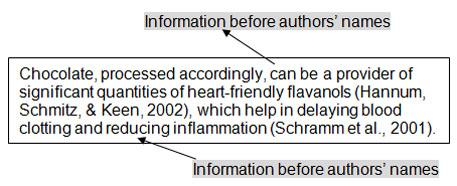
Such citations are called information-centred citations.
When the focus is more on who is saying it then the citation is written like this:

Such citations are called author-centred citations.
Try and achieve a balance between both types of in text-references in your essay writing.
Reference list
In the APA style of referencing, the reference list has certain conventions that you must also follow. Here are some examples from the chocolate essay:
Don’t make referencing something you do just as an editing or proofreading activity. Include your in-text citations and reference list as part of your first draft.
An excellent website to help with your APA referencing is the APA Interactive tool at Massey University.
-
Redrafting your essay
Leave yourself enough time to look at your essay more than once. For a 1000 word essay you need at least three days to redraft your essay.
Always save each draft as a separate file; then you can see how your essay develops and improves.
Here are the sorts of questions you should ask yourself:
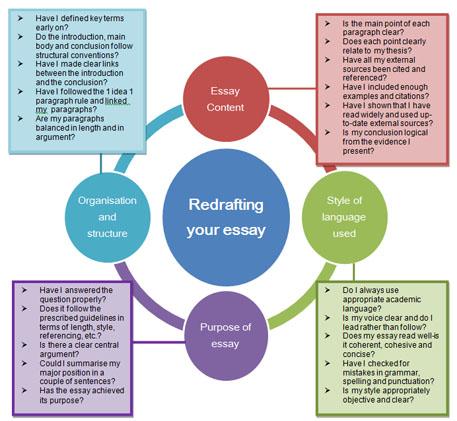
View a text version of the redrafting your essay diagram above.
You can also look at other checklists such as this one on editing your own work.
Let’s see how the writer of the chocolate essay redrafted their original introduction:
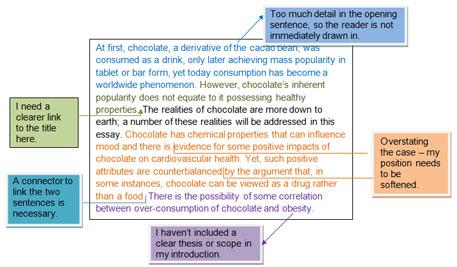
View the text version of the redrafted essay.
Now compare the above with the final draft:
Since Spanish explorers brought back chocolate from the new world, chocolate consumption has become a worldwide phenomenon. At first, chocolate, a derivative of the cacao bean, was consumed as a drink, only later achieving mass popularity in tablet or bar form. However, chocolate’s inherent popularity does not equate to it possessing healthy properties, as suggested by the title. The realities of chocolate are more down to earth; a number of these realities will be addressed in this essay. Chocolate has chemical properties that can influence mood and there is possible evidence for some positive impacts of chocolate on cardiovascular health. Yet, such positive attributes are counterbalanced somewhat by the argument that, in some instances, chocolate can be viewed as a drug rather than a food. Moreover, there is the possibility of some correlation between over-consumption of chocolate and obesity. Thus, it will be argued that despite chocolate’s positive effect in some cases on mood and the cardiovascular system it has also been linked to addiction and obesity.
Take your time and be careful when redrafting—it will be worth it!
-
Incorporating your own voice
How do you write in an academic way?
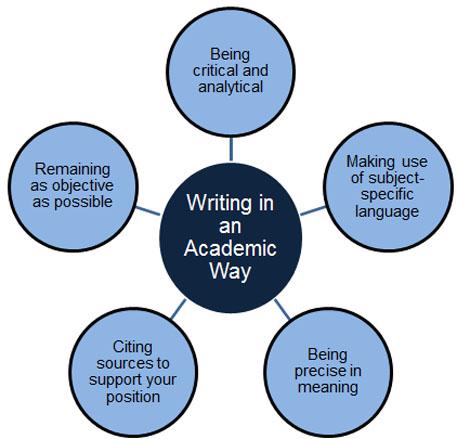
Your lecturers will want to hear your ‘voice’ as they read your essay.
Imagine your essay as a kind of story. You are the principal storyteller, the internal voice of the writer, leading the reader through to your conclusion.
During the story, there are different voices that appear from time to time. These are the external voices (citations) that add substance to your story, providing detail and support for what you are saying and sometimes even giving an alternative perspective. The external voices can be divided into two categories in your essay: the direct external voice of an author (through a direct quote) and the indirect external voice of an author (through a paraphrase).
The reader needs to know at all times whose voice they are hearing. Is it your internal voice or the external voice of other authors?
You might wonder how you can include your own voice and still sound academic when you are writing about a subject area in which you have little (or no) knowledge. Including your voice does not mean that you should say ‘I think’ or ‘in my opinion’.
Here are some examples of the critical/analytical language that you can use as your own internal voice when you present other people’s ideas:
Phrase How your voice is included It has been argued (Smith & Jones, 2010) that… Pointing out what has been said by an external source As Smith and Jones (2010) note… Showing your agreement with the external source However, Smith and Jones (2010) fail to address… Showing that you recognise the limitations of the source Seemingly, Smith and Jones (2010) have… Showing you have tentative support for the external source On the other hand, Smith and Jones (2010) argue that… Showing that there is a contrast with a previous argument you have included Smith and Jones (2010) assert that… Showing that the position of the external source is strong but you are likely to have doubts about it It has been suggested that… (Smith & Jones, 2010; Brown & Culbertson, 2005; Lloyd & Giggs, 2004) Showing that you recognise a number of authors have reached a similar conclusion, and you might/might not agree with it One advantage of the work of Smith and Jones (2010)… Showing that you are positively engaging with an external source Let’s look at one of the paragraphs from the chocolate essay to see how the text is an interplay of the internal voice of the writer and the external voices of other authors.
The internal voice of the writer is colour-coded in yellow; the indirect external voices of other authors (i.e. paraphrases) are coded in grey; and the direct external voices of other authors (i.e. quotations) are coded in blue.
View a text version of the voice explanation above.
This is a balanced paragraph. The writer sets the scene at the beginning of the topic sentence and also links together all of the sentences, using their own voice to lead into content which is provided by the external voices.
Look at the same paragraph re-written, with the amount of the writer’s voice substantially reduced:
Here the writer is not ‘in charge’ of the paragraph, and it reads a little like a list. That is something your lecturers do not want to see.
When you are drafting your paragraphs, use a colour-coding system like the one used here. It will help you ensure your academic voice is clear!
When you get more confident in using external sources, you will gradually expand the language of your critical internal voice. The Phrasebank website at Manchester University provides examples of some more expressions to use when assessing external sources.
-
Proofreading and editing your essay
Editing focuses on the big picture elements such as overall structure, appropriate paragraphing and whether the question has been answered.
Proofreading has a micro-focus on the details of your essay, such as formatting, grammar and punctuation.
Everybody has their own personal style of editing and proofreading. You need to focus on the types of errors you commonly make by looking at the marker’s comments on your previous work.
Some people proofread alone; some get other people involved. Having others involved is a really good idea.
Fresh eyes can help you find things you might not otherwise have seen.
Here are some things to consider when proofreading and editing:

View a text version of the above proofreading and editing your essay considerations.
The Purdue OWL website has even more detail on the proofreading process.
-
Submitting on time
Students regularly underestimate the time it takes to write an essay, in particular the planning and researching stages.
Before you begin your essay, have a look at the Massey University assignment planning calculator.
You might be surprised how long the whole process takes!As you can see from the assignment planning calculator, if you only start your essay a few days before the due date, you will have to do things too quickly.
If you think of the essay/cake analogy, you need time to mix all the ingredients properly, or the end result will not be what you want to share with others!
To write a 1000 word essay, ideally you should allow yourself about 3 weeks.
Let’s have a look at how an essay time management ‘cake’ could be divided into slices:
You can see that the biggest part of your time is spent on the planning/research elements and redrafting/editing/proofreading elements, which together should comprise around 60% of your time.
Have a look at another model to see what you also need to consider:
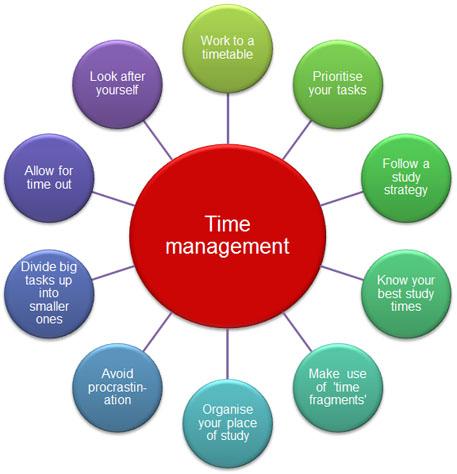
-
Essay example
-
Academic integrity and plagiarism
‘Integrity’ relates to ‘honesty’, and academic integrity involves writing in an honest way, so that no one will think you are claiming that words or ideas from someone else are your own. This is very important in academic writing in western countries, and if you do not do this you might be accused of plagiarism, which is a serious offence at university.
Plagiarism means using someone else’s words, ideas or diagrams without acknowledgement.
Of course, when we write an essay we need to refer to other people’s ideas. We gave some of the reasons for this before:
- To show respect for other people's ideas and work
- To clearly identify information coming from another source
- To distinguish an external source from your interpretation or your own findings
- To support your own arguments, thus giving you more credibility
- To show evidence of wide (and understood) reading
Being a good writer involves using other people’s ideas to support your work. However, you should never forget to say where these ideas come from, even if you don’t quote the person’s exact words.
Include a reference in the text, where the words or ideas appear, and in a reference list at the end of the essay.
All the references in the text must appear in the reference list, and all the references in the list must also appear in the text.
There is a short video clip on plagiarism here and a wonderful Plagiarism Carol video here (click on ‘captions’ to get subtitles in English).
Another word connected to academic integrity is collusion.
Collusion means that you work with someone else and submit the same or very similar assignments without your lecturer’s permission.
For example, if you and a friend work together on an essay and then submit identical or very similar versions of the essay, one under your name and one under your friend’s name, that is collusion. However, if you are doing a group work assignment and your lecturer has asked you to work together and submit the assignment jointly, that is not collusion. Collusion, like plagiarism, has an element of dishonesty in it. People who collude do so secretly, as they know that the lecturer would not be happy.
People make genuine mistakes, so lecturers are usually very happy to advise you if you ask them.


